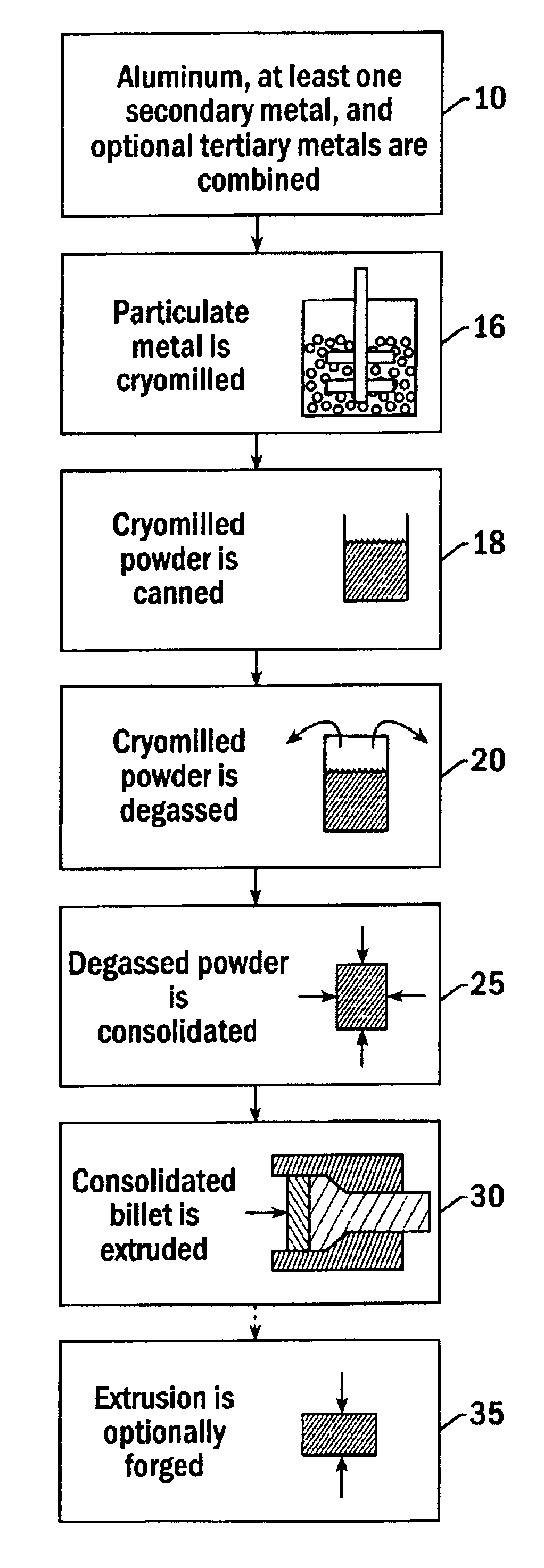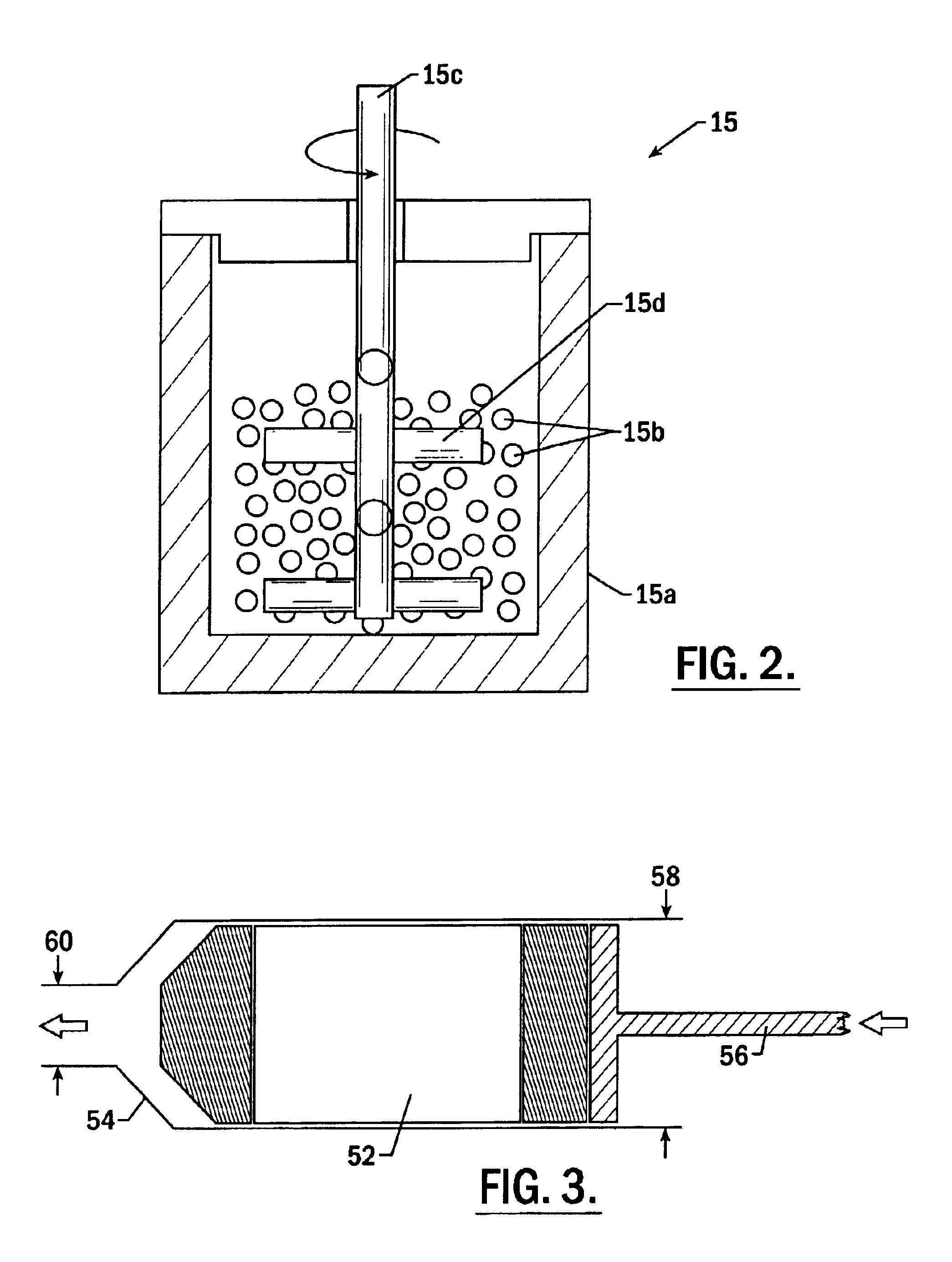Method for preparing cryomilled aluminum alloys and components extruded and forged therefrom
a technology of aluminum alloys and components, which is applied in cryogenics, metal-working apparatuses, transportation and packaging, etc., can solve the problems of reducing the usefulness of aluminum and titanium alloys. , to achieve the effect of high capacity, high strength and maintaining or improving strength
- Summary
- Abstract
- Description
- Claims
- Application Information
AI Technical Summary
Benefits of technology
Problems solved by technology
Method used
Image
Examples
example 1
Production of Aluminum / Magnesium Alloy
[0066]Aluminum alloy powders of composition 6.7 wt % Mg+Al (balance) were cryomilled, canned, degassed, consolidated, and extruded into a 3″ diameter bar. Cryomilling was carried out as follows. The attritor was filled with 640 kg grams of 0.25 inch diameter steel balls. Liquid nitrogen was flowed into the attritor. Flow was maintained for at least about one hour to cool the balls and attritor until the rate of boil off was sufficiently low to allow the balls to become completely submerged in the liquid nitrogen. A transfer hopper was loaded with 17445 grams of aluminum powder, 2555 grams of 50 wt % aluminum 50 wt % magnesium powder, and 40 grams of stearic acid. Loading of the hopper was carried out in a glove box under dry nitrogen purge. These components were transferred from the hopper into the attritor by draining from the hopper into a tube inserted through the lid of the attritor vessel. The attritor arms were then rotated in brief pulses...
example 2
Production of Aluminum / Magnesium Alloy
[0070]Aluminum alloy powders of composition 8.5 wt % Mg+Al (balance) were cryomilled, canned, degassed, consolidated and extruded into a 3″ diameter tube, wall thickness 0.25″ as described in Example 1. In this case, the extrusion area ratio was 23:1, the ram speed was 0.02 inches per second, and the average strain rate was 0.055 sec−1. The extrusion had the tensile properties shown in Table III. The extruded tube exhibited physical properties that were superior to those of tubes having similar metallic components produced by traditional methods.
[0071]
TABLE IIIσy (ksi)σu (ksi)elong. (%)R.A. (%) 70 F. - long.73.478.314.231.5 70 F. - trans.71.477.56.713.6−320 F. - long.85.891.612.216.1−320 F. - trans.85.689.47.010.9
example 3
Production of Al / Mg / Zn / Cu / Co Alloy
[0072]Aluminum alloy powders of composition 2.5 wt % Mg+8.0 wt % Zn+1.0 wt % Cu+1.4 wt % Co+Al (balance) (composition similar to AA7090) were cryomilled, canned, degassed, consolidated and extruded into a 0.4″ diameter extrusion according to the method of Example 1. The extrusion had the longitudinal tensile properties shown in Table IV, which are superior to those corresponding alloys which were not treated in accordance to the invented method.
[0073]
TABLE IVσy (ksi)σu (ksi)elong. (%)R.A. (%) 70 F.104.81076.37−320 F.126.8129.11.84.7
PUM
| Property | Measurement | Unit |
|---|---|---|
| weight % | aaaaa | aaaaa |
| temperature | aaaaa | aaaaa |
| temperature | aaaaa | aaaaa |
Abstract
Description
Claims
Application Information
 Login to View More
Login to View More - R&D
- Intellectual Property
- Life Sciences
- Materials
- Tech Scout
- Unparalleled Data Quality
- Higher Quality Content
- 60% Fewer Hallucinations
Browse by: Latest US Patents, China's latest patents, Technical Efficacy Thesaurus, Application Domain, Technology Topic, Popular Technical Reports.
© 2025 PatSnap. All rights reserved.Legal|Privacy policy|Modern Slavery Act Transparency Statement|Sitemap|About US| Contact US: help@patsnap.com



